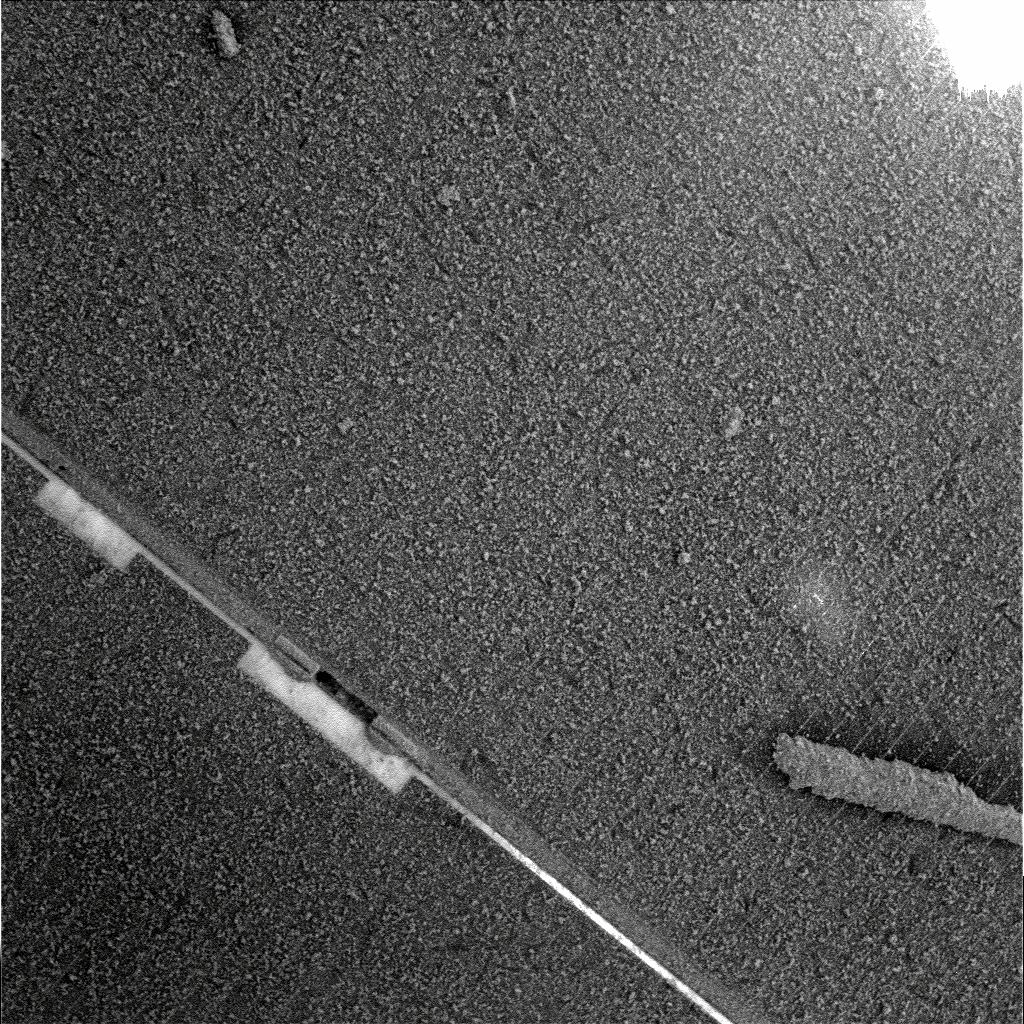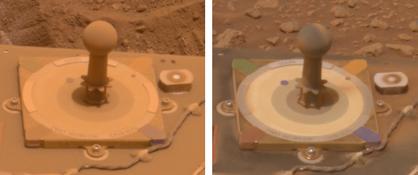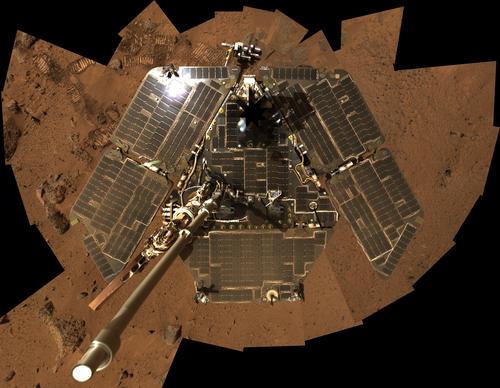Steve Squyres and the Mars Exploration Rover team knew from the beginning that dust could cause a problem for the rovers, Spirit and Opportunity. When a thick layer of dust coats the solar panels, it blocks the sunlight that generates power for the six-wheeled robots. In the summer of 2007 a huge dust storm blanketed Mars, and deposited a fair amount of dust on solar panels of both rovers. Spirit, especially accumulated a lot of dust on its solar array. Currently, only about one-third of incoming sunlight is able to penetrate dust on Spirit’s solar panels to be converted to electricity. As a result, Spirit is experiencing the lowest energy levels to date and accumulating a backlog of data waiting to be transmitted to Earth. If only a dust devil would come along!
Spirit’s solar array input has been approximately 240 watt-hours per Martian day, or sol (100 watt-hours is the amount of energy needed to light a 100-watt bulb for one hour). The skies in the area are now clear, which means additional dust shouldn’t be accumulating on the solar panels, and sunlight should be abundant. But clear skies also mean lower temperatures on the surface of Mars, increasing the bitter cold experienced by Spirit’s rover electronics module during the current Mars winter. Nighttime temperatures are creeping closer to the point where they will trigger the survival heaters, which draw a large amount of power.
The rover team has been using the strategy of keeping Spirit awake long enough each day to keep the electronics module sufficiently warm with heat from normal operations, providing more time for science observations. However, recently the team has done less science operations in order to allow Spirit’s batteries to recharge. The engineers are being creative in the trade-offs the team makes each day to keep Spirit going through the Martian winter. Another way they are conserving energy is by restricting the number of sols on which Spirit receives direct-from-Earth instructions via the rover’s high-gain antenna and transmits data to Earth via the Odyssey orbiter.
The MER team is hoping for a dust devil event to come and clear off the solar panels, like these dust devils did back in 2005.

This image shows the difference in the dust accumulation before and after the dust-cleaning event back in 2005.
And this is a self-portrait the rover took of its cleaned solar panels in 2005. Here’s hoping Spirit can be wiped clean again, and the sooner the better.
Original News Source: Mars Rover website




I wonder how practical it would have been to install a couple of little blowers or fans. 🙁
Long live Spirit and Opportunity.
Al is right, I was thinking that if they have any power at all, couldn’t they put a little broom on there for a sweep? One sweep should get a good percentage of power back.
One would wonder if the apparatus used to deploy the solar panels could be activated and maybe cause some of the dust to fall off.. I am surprised that if they knew dust would be a problem that they did not design in a workable solution such as turning the solar panels perpendicular so that some if not most of the dust would fall off…
My guess is that they truly were expecting a short mission, so didn’t think dust would be a factor.. At least I hope that was what they were thinking.
Let’s hope it will be taken into consideration for the MSL and future missions.
I remember NASA when they didn’t know the meaning of the words “we can’t” or “it’s impossible”. If they knew the dust was going to be a problem, why didn’t they come up with a way to solve the problem?
Don’t get me wrong, the rovers are fantastic, they’ve gone well over their anticipated expiration dates, and the science they are providing is wonderful. But I wonder how much longer they would be able to work if those people who knew of the shortcomings, actually saw fit to fix the problem.
A high pressure vessel connected with a hose to a tipped blower at the end of the arm would have worked.
JPL’s approach to the dust accumulation issue was just to put as many solar cells on the rovers as the mass budget and size would allow. Any other solution involves added complexity – and keep in mind that mass is a critical commodity onboard a spacecraft. Taking a kilogram or two of compressed air just in case it might help clean the arrays is NOT an option!
Well, thankfully, I doubt that they will use solar panels anymore.. at least for rovers.. I think they will go exclusively with radioisotope generators and nuclear power from here on out. It still wouldn’t be a bad idea to put a blower on, if practical. Just to keep the crap off.
Btw.. No need to bring compressed air. Mars has an atmosphere, compress it on the ground. Just need a little compressor. (if practical).
Also, the rovers use radioisotope generators for heating. The MSL shouldn’t even have any solar panels.. I guess the technology just wasn’t there at the time.
A lighter weight solution would be a system based on the small ultrasonic vibration devices newer digital SLR cameras use to remove dust from their sensors. Just orient the panel at an angle and send a short burst of power to an ultrasonic motor attached to the panel. The dust should slide off.
Could they not just drive up a ‘south’ facing slope so that a) the sun shines more directly on the solar panel (like the roof of a house) and b) maybe even help some of the dust blow off the panel?
Another more natural solution would be to have the rovers find something big enough to just bump into, a rock obviously. If it’ big enough to span across both front or back wheels, with the panels tilted, it could just make a repeated forward and backwards movement until a good amount of dust falls off. Another thing is, if just by making a continuous forward or backwards movement against the rock, the vibration from the wheels turning alone, should shake away the accumulated dirt. 🙂
The last couple of comments are interesting. They seem plausible. Don’t know what power it (they) have left in them.. If they would be capable of performing such maneuvers, though. I don’t have an inside track with JPL… I am thinking, though that the solar cell surfaces may be electrostatic so it may take a good breeze to do the job… But I’m just guessing. I don’t know.
I do believe, however, that we shouldn’t spend a considerable amount of time (and money) trying to get them operational again – once failure occurs – if we don’t think we will get much more usage from them. But let’s hope for the best. I would love to see them still in operation 10 years from now.
You’ve all come up with some interesting solutions, and unfortunately, its too late to change the design of the current rovers. But the engineers might keep the current dust issue in mind while designing the next generation of rovers. One important thing to remember is that no one thought the MER would last this long, so that we’re having this discussion of how to make the rovers last even longer is a great testament to those who built them.
A couple of folks here mentioned positioning the rovers so that the dust could slide off. Unfortunately, the dust has a magnetic quality to it, and it sticks to the solar panels quite well, unless a big gust of wind comes up. And as for bumping rover to knock the dust off… well, I don’t think they’re going to try that one either! Too risky.
I am absolutely awestruck by the fact that the rovers have lasted long enough to actually become Dusty. How incredible an achievement! It would be nice to remove the dust somehow, maybe traveling at maximum velocity for a short distance then reversing direction abruptly, but even if this is not feasible the mission has been a huge success.
Spirit has been working on Mars since on January 4, 2004 – far beyond anyone’s expectations. This has been one of NASA’s most amazing successes. Even if it died today and as never heard from again, I would say that that they did everything right!
It seems apparent that there is clumping of material and different sized particles on the panel surface, even what looks like pebbles. There is also an elongated clump with a clean area around it. Designers of future solar-powered rovers may consider an electrodynamic system for removing what appears to be particles deposited and held together by electrical forces (no way the Martian winds will throw pebbles since they theoretically don’t even have the force to create the dunes by particle transport). How could simple wind deposition create the elongated feature? I doubt mechanical means will rid the rover of this stuff if it’s stuck on electrically. And I don’t thinks it’s magnetism…are solar panels magnetic? See if a steel shaving sticks to one. I also note that the metal edging the panel hinge is clear of debris…it will be incapable of charge buildup. The dielectic of the panel surface can retain a charge.
typo….I meant “dielectric”
What a Dilemma!?
I have read the above comments above and then, I gave this a little thought. Because I, like others don’t want anything to go wrong with all of Hard Work and Highly Skilled Engineering that went on to create such an incredible Humanmites crawling around.
What about creating Air Nozzles strategically located in various areas around the crawlers.
And as soon as the landing is completed, a device similar to Carburetors on a car engine.
Whatever air is available, will be Compressed into a couple or more chambers. They would be monitored to maintain what Pressure is needed.
When Dust has reached it’s maximum collective count, the system would then release the compressed air Laterally across
the panels and the Dust would then be Blown away by the pointed nozzles!
The biggest problem for me to wonder about, is replacing the Air back into the compression chambers by way of the carburetors!
If I remember correctly, there is air on Mars, but very limited. Any, would be enough!?
I think the system would not have to be running continuously, therefore, what little air there is, should be enough to allow the system to work!?
Bill- have you seen the photos of rocks that have been blown by the wind on Mars? Sure- there were extraordinary circumstances, but don’t discount strange things like that, also far-flung pebbles from meteorite impacts. Pebbles flicked up by compression between the rover wheels and a rock. I’m sure I could think of several more ways that larger particles might get deposited on the rover…
Do the rovers still have the capability of raising the solar panels to the original stowed position? If the same screw mechanism that lowered the panels could now raise the panels vertically some or most of the dust would slide off, especially if a little jarring action could be added in the routine.
Hello Brad, The wheels are _under_ the panels, so I think flicking is out. Also the vehicle moves exceedingly slowly. So I think this is a low probability that the rocks bounced there. However the stronger argument for charging is the elongated pattern, which is hard to explain otherwise, as well as the absolute cleanness of the metal part. I’m all ears for an alternate explanation for these latter points.
Why not windshield wipers for the solar panels? Another option would have been to install transparent shades to cover the panels during dust storms, and retract (downward, of course, to remove the dust) when the storms have passed.
I know this isn’t breaking news at the moment, but why don’t they use some sort of wind power in conjunction with solar. There appears to be plenty of supplementary wind around, and overnight it could continue to charge the batteries, or keep them warm so they can do more science. Just a thought .. .. ..